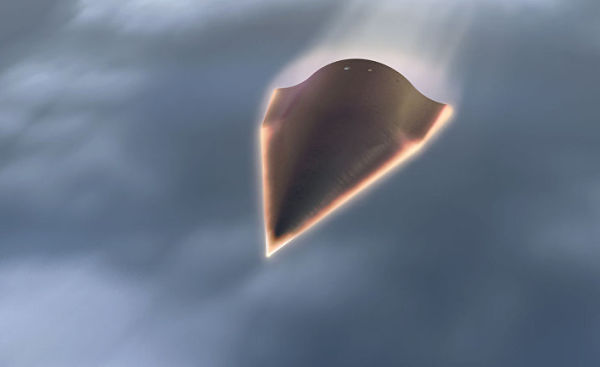Warheads placed in orbit strike quickly and anywhere on Earth — a widely accepted and fundamentally incorrect picture. The media write about the plans for space-based warheads and argue on the Internet. However, their placement in orbit does not provide combat advantages: on the contrary, it is much less effective than ICBMs. Let's find out why this is so.
The ICBM warhead from different sides
Let's briefly recall and compare what we are talking about. "Your word is firm," the ancestors used to say. A ballistic missile is called an intercontinental missile if its range reaches 5,500 km or more. It is measured by orthodromy, the shortest line on the Earth's surface between the launch and drop points of warheads.
In the time of S. P. Korolev, the head of the rocket was separated from the last stage and fell completely, which is what it was called in the documents (abbreviated as GCH). Later, there were several warheads (nuclear charges) in the GCH, and each received a separate design for delivery to the detonation point. These are warheads, or warheads.
The semantic difference between these two names is unknown to the author and has never been encountered, so we consider them synonyms. In the official top—secret working documents for each combat operation (ICBM test launch), and countless target designations that I've worked with, it was always invariably written BB - combat unit.
The term "warhead" was used in the equally official OSV-1 and OSV-2 treaties. The Terms and Definitions annex to the treaty interpreted it as follows: "A warhead is a part of a warhead that is capable of being preserved upon return through the dense layers of the Earth's atmosphere and is designed to deliver weapons to a target or test such delivery." There is no difference with the combat unit.
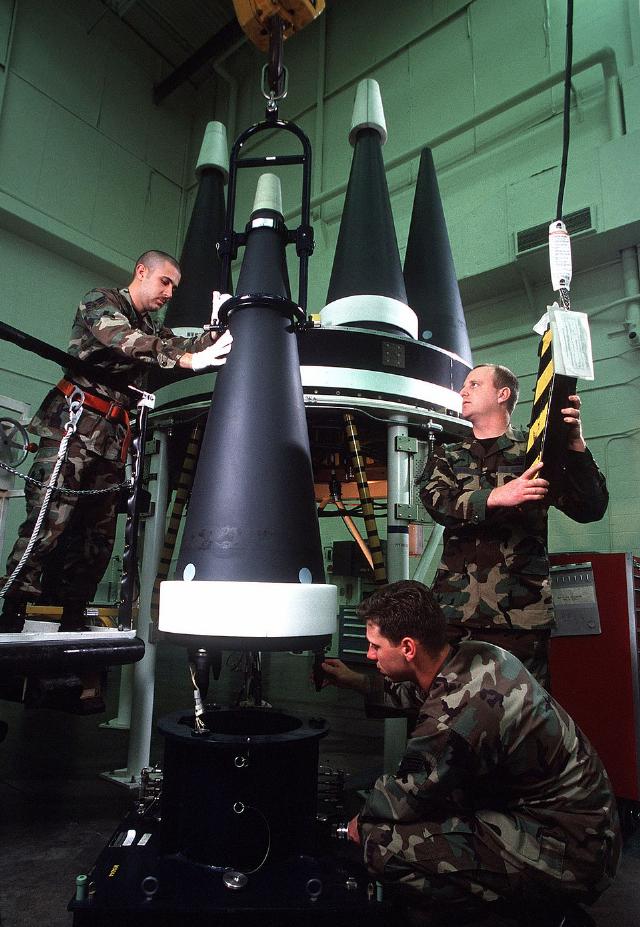
U.S. Air Force maintenance crews are being trained on using an overhead crane and a lift to remove and install warheads from the launch stage of the MK-21 Peacekeeper missile at Vandenberg Air Force Base, California / Photo: Andy Dunaway, en.m.wikipedia.org
Structurally, it is a special aircraft for flight in space and the atmosphere in various hypersonic modes. Specialization for space is weakly expressed, more often just by the tightness of the hull. The main specialization for atmospheric flight is: It has a conical shape, is aerodynamically stable, and many other design features.
Early warheads had an extended braking aft skirt and a blunted nose section, which created a detached head shock wave in front of them, slowing flight. With the development of heat-shielding technologies, the strategy of passing through the atmosphere changed in favor of maximum speed, and the warheads became conical, sharp-nosed "carrots".
The cone angle minimizes integral (over the entire atmospheric path) velocity losses from aerodynamic friction and gas-dynamic compression of the flow. According to American research in the early 1970s, such a minimum gives a cone angle of 17-18°; later it became the norm for warhead hulls.
The thermal protective coating protects the structure from temperature and heat flow during hypersonic flow. Let's leave aside the features of the TPN and its behavior in a hot flowing stream, heat shocks and chips, a change in the shape of the nose due to burnout, and other matters that are reflected in the miss, but have little effect on the overall ballistics of movement. These are many interesting, but special questions that we will leave now. The power structure of the hull can withstand the pressure of the compressed outer air layer, large braking overloads and various gas-dynamic vibrations that change in flight.
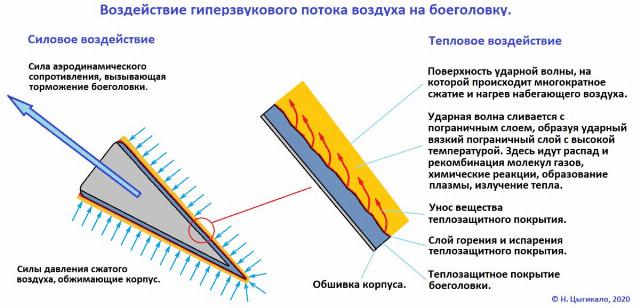 |
| The effect of hypersonic air flow on the warhead. |
| Source: Nikolay Tsygikalo |
Inside the warhead there are a number of systems, the main of which is a warhead, a charge from a thermonuclear explosive part and an automation unit. It is connected to the external part of the protection and cocking system, and the detonation system in the form of various contact sensors and altimeters of various kinds (barometric and radio altimeters of different ranges). The charge temperature control system maintains its operating temperature.
There is also an on-board power grid with power sources, and a communication line with the missile's combat stage (which opens when the warhead is separated). There is also an inertial measurement system for adaptive detonation, a twist system around the longitudinal axis, pneumatic systems, devices for various controls and regulations, and other various equipment.
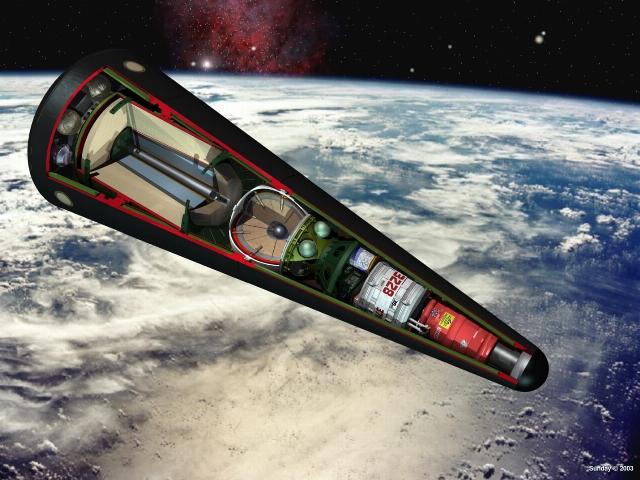
W76 thermonuclear warhead with a capacity of 100 kilotons, located inside the Mk4 combat unit. This warhead is used to equip Trident II intercontinental ballistic missiles (along with the W88 warhead) / Image source: Josef Witton, X.com
Visually, it looks very, very tightly packed into the body of the warhead, you can't put your finger through it, with a mass of all kinds of equipment, blocks and modules, closely entangled with branching cable bundles, metal tubes, and all this in an overload- and vibration-resistant design (tied, wrapped, secured, secured). Today's ICBM warhead is small, about the length of a man and weighing a quarter ton.
Flight of the Valkyries
After turning off the engines of the last upper stage of the rocket, the combat stage, or the breeding stage, separated from it, guides the warhead — aligning its trajectory with the target point. During this process, the combat stage adjusts its movement in space in a precise, high-precision manner and separates the warhead, which begins independent flight from that moment on. It is free, that is, it occurs under the influence of only the force of the Earth's gravitational field (the other effects are ignored in the first approximation). We discussed the details and algorithm of the combat stage using a specific example here, in the chapter "Breeding stage, or combat stage".
The warhead rises to its apogee (highest) at a point of the trajectory lying at an altitude of hundreds of kilometers, and passes to the descending part of the trajectory. According to it, the warhead enters the atmosphere and passes through until the charge is detonated (we discussed the suborbital trajectories in more detail here, the flight of the warhead in the atmosphere here, the operation of the automation unit and the detonation of the charge here ).
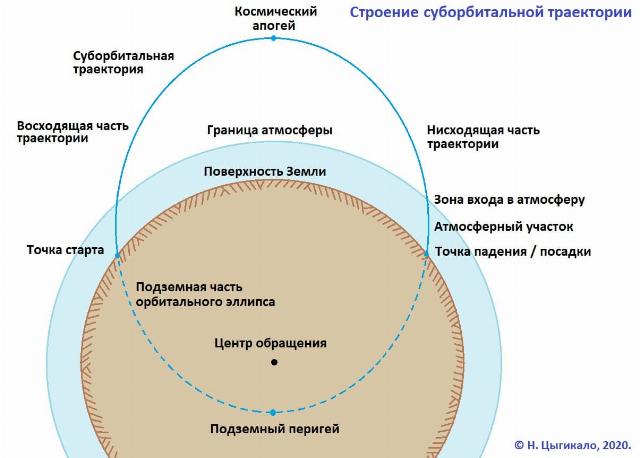
The flight range is a consequence of the speed of the warhead. The maximum ranges of ICBMs are in the range of 10 — 12 — 14 thousands of kilometers. To achieve them, the rocket accelerates the combat stage to a speed of 6.5 — 7.3 km/s. The vector of this velocity is not directed horizontally, as in space launch vehicles, but at an angle above the current horizon. Therefore, the climb along the trajectory continues even after acceleration stops. The speed at apogee is reduced to a minimum (excluding the atmospheric section), but it still amounts to several kilometers per second, with increasing launch range increasingly approaching speeds in circular near-Earth orbits.
ICBM straddling orbit
In the late 1960s, the designers expressed the idea of accelerating the warhead (then still the head) to orbital speed. Once in orbit, the GPS can fly indefinitely far along it. Not only to the opposite point of the Earth at a range of 20,000 km, but also further if the target is less protected or not at all protected from this direction of approach.
This is how the R-36orb rocket with an orbital warhead was developed, tested, put into service and put on combat duty in the USSR. This is the well-known heavy ICBM R-36, a late modification of which is still on combat duty today under the name "Satan" (under the index 15A18M, it underwent flight tests, in which the author also completed a dozen launches).
The R-36orb launched a 3.6-ton warhead into orbit. It included a braking stage and a 1.7-ton warhead with a megaton-class thermonuclear charge. In space, the orbital head unit (OGF) used an inertial control system to calculate the current range, orientation, and stabilization of the entire space assembly. Her work was complemented by a radio altimeter that determined the height at the beginning and end of the orbital section. When the desired range was reached, the braking stage turned on the propulsion system and switched to the descent trajectory, after which it separated the warhead.
The orbital head of the 8F021 rocket R-36orb. On the left is the descent part of the DZ-2, that is, the warhead itself with the warhead. Its nose is blunted to enhance gas-dynamic braking in accordance with the then paradigm of atmospheric passage. On the right is the brake step 8F673 and its schematic device. A large degree of expansion of the RD-854 engine nozzle, designed to operate in space, is visible. And the characteristic wide hollow sockets of the pitch and yaw stabilization nozzles operating under braking by the main engine / Image: kosmonavtika.com, Vasily Saveliev
In 1968, the system was put into service, and in 1969, three regiments with the R-36orb missile in their mines went on combat duty at Baikonur. They carried it for 14 years, after which the missile was decommissioned under the OSV-2 treaty.
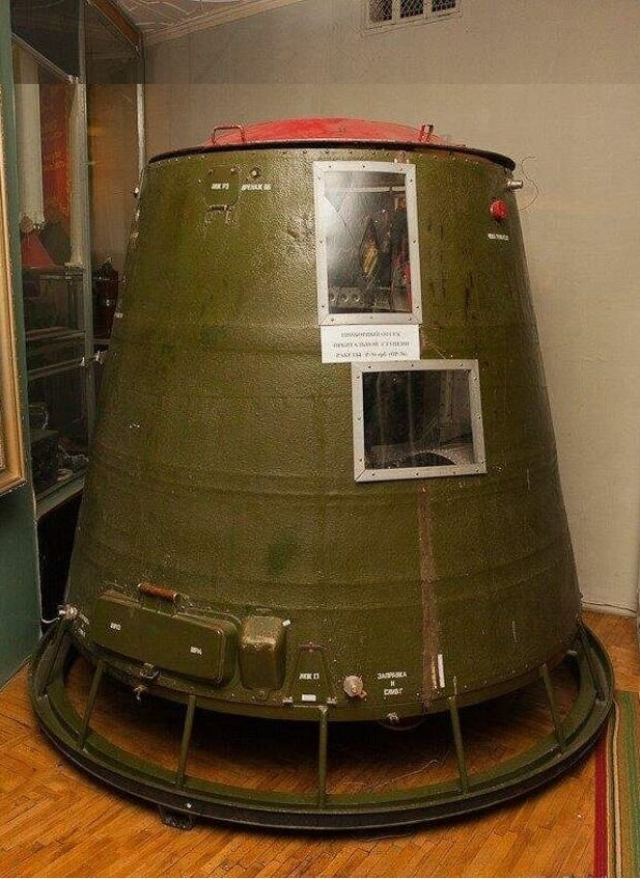
The body of the braking stage 8F673 of the orbital head 8F021 of the R-36orb rocket / Photo: S. Petrov, Vk.com
At the beginning of 1967, the first successful orbiting of the Earth took place. Launched from Baikonur, the UHF completed an almost complete turn in 94 minutes of flight, delivering the warhead near Astrakhan to the territory of Cape Yar. The accuracy of the impact from orbit was low by today's standards: the circular probable deviation from the aiming point was 1.1 km, the maximum reached 5 km. To compensate for such a miss, megatons of charge were needed.
The "head" was sent into orbit only during combat use or test launch, repeating the ballistics of combat. The orbital movement was short-lived, in combat use not reaching a complete revolution around the Earth. In its ballistic nature, the launch of the R-36orb was a launch of a conventional ICBM, into the trajectory of which an "extension cable" was "sewn" — an orbital piece of the path that increases the range.
In the iron shackles of the orbit
But what if a launch vehicle or a warhead were launched into orbit in advance so that it would be permanently on combat duty and based there? And when the "x-moment" comes, give her the command to defeat the target. After that, the UHF will fly to the target area, turn on the braking engine and descend from orbit to the target trajectory.
Yes, it is quite possible to do this, and it will work. On one condition: if the target lies ahead on the path (ground projection of the orbit) of the warhead. Or in close proximity to it, in a narrow lane along the highway: the braking impulse can be set with a side component. It will inform the warhead of the lateral velocity for displacement during the descent from the initial route to the target. It won't take much sideways, because the orbital velocity is huge, and for a significant reversal of the velocity vector, a large lateral velocity is needed, which means a large mass of fuel for the engine.
Let's take a look at what an orbit is. Many intuitively imagine it as complete freedom; maybe it's subconsciously because of the orbital weightlessness? In fact, the orbit is an iron vise, rigid and inexorable. Why? The reason for this is the enormous speed in orbit. Especially in the fastest of all circular orbits, the low reference orbit with an altitude of 200 km, where it is 7788 m/s. This speed value creates stability of the orbit (along with another factor, which is discussed below): it is difficult to do anything quickly with such a huge speed.
Note that this is by no means the first cosmic velocity. The first space station is calculated for the spherical surface of the planet without relief and atmosphere. This is the orbital velocity in a circular orbit of zero altitude on a celestial body. It characterizes the ballistic conditions on the surface of a body: with what minimum energy it is necessary to launch from there to enter orbit. Naturally, it is also minimal, that is, circular at zero altitude; with increasing altitude, the energy of excretion only increases. For the surface of a celestial body and the gravitational conditions on it, the numerical value of the first cosmic velocity is calculated and included in the reference books.
A bit of ballistics in fiction mode
You can rotate the velocity vector in space only by adding the vectors: the second vector will turn the total velocity to the desired angle. It is more economical to set it perpendicular. The ratio of the additive to the fundamental velocity will become the tangent of the rotation angle. The ratio of the lateral speed to the main speed at the turn by one degree will be 0.0175. To deflect the orbital velocity of 7788 m/s by one degree sideways, a lateral velocity of 136 m/s is needed.
In free motion (which is what draws the Keplerian orbit), by definition, there are no forces that create lateral velocity. There are many such forces in real near-Earth motion: from the oblique intersection of the Earth's equatorial "hump", the attraction of the Sun and other planets to the pressure of sunlight and the reactive forces of radiation from radiators of temperature control systems. But they are very weak, and all together they will give a lateral velocity of tens or tens of m/s per year. Their work is evident only during the months of flight.
It resembles a gyroscope, which is stable for the same reason of the high rotation speed and linear velocity of the gyroscope points. Turning the orbital velocity sideways means turning the plane of the orbit, and this is a very energy-intensive maneuver.
This is not the case in aviation: an airplane can easily change its course in any direction and any number of times. Or it will simply turn into a turn — a horizontal flight in a circle with a roll and a continuous turn of the course, the aircraft is not worth the additional fuel costs. An aircraft can deviate from its course by wind or errors in control and execution systems: it is carried away by both the air environment of its movement and its own work in the air. The movement in orbit is much more stable due to the freedom (passivity) of movement and the immutability of the gravitational field itself, which does not go away and does not change in any way. And this is the second factor of orbital stability, along with high orbital velocity.
Therefore, the warhead in orbit flies only straight ahead. And after the braking impulse of the descent from orbit, it will fall ahead in the course of its orbital motion. With the exception of a small drift by ballistic wind (integral wind drift during atmospheric passage) and errors in the output of the braking pulse (its orientation, strength and duration). And if the target is not exactly on the flight path? The engine can deflect the movement by a degree with a lateral acceleration of 136 m/s. This is a fairly large change in velocity (about the same amount is needed to descend from a low circular orbit), and requires a fair amount of fuel.
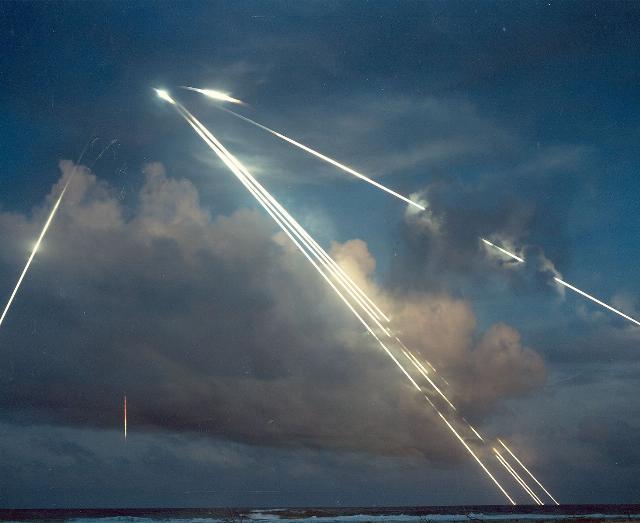
The entry of MX missile warheads into the atmosphere at the receiving range of Kwajalein Atoll / Source: en.m.wikipedia.org
An ICBM warhead passes through the atmosphere in about a minute (there are different entry angles and time), starting to glow from a height of 100 km. Before that, it still has a couple of minutes to descend from a 200-km orbit (the braking impulse is given almost horizontally, and the decrease increases gradually). It can take three to four minutes to descend from orbit. A deviation of the course by a degree during this time will move the point of fall sideways from the initial route by 24-33 km; let's say it is estimated at 50 km. Thus, a warhead with a powerful lateral acceleration engine can attack targets to the right and left for 50 km, that is, lying in a 100-kilometer strip of its orbital path. And this is the whole freedom of impact from orbit.
Let's make a small but important methodological digression. Ballistics loves and always contains numbers: numbers will show estimates and comparisons, and make the look meaningful. Therefore, we take and use the simplest and roughest estimates (the so-called approximate numerical characteristics). Exact numbers are both unnecessary and undesirable, so as not to accidentally write something that should not be published. We will take a conditional thousands of kilometers, a conditional rocket, a conditional flight time. But these conventions are quite consistent with the real meanings and the picture.
In terms of impact efficiency, an orbit with an ICBM is not a pair
There is a time for operational use for all flying weapons. A plane taking off from an aircraft carrier will reach its target in 30-50 minutes. An anti-tank rocket-propelled grenade will hit the target in 10-15 seconds. ICBMs fly a conditional 6,000 km in a conditional 21-23 minutes (from practice), an average of 22 minutes, this is the most likely picture. That means a maximum range of 12,000 km. the time will double to 44 minutes. With all sorts of additives, another minute will pass, let's estimate the flight time at about 45 minutes.
At the longest ranges of heavy ICBMs (for example, the Sarmat is declared with a maximum of 14,000 km), the time will be 52-55 minutes (purely intuitively). What will the orbit show during this time? At low altitudes, a revolution around the Earth takes an hour and a half, 90 minutes. The circumference of the Earth (at the equator) is 40,000 km. The opposite point lies at an orthodromic range of exactly half the circumference, or 20,000 km. This path through the orbit will take half the time of the orbit, 45 minutes.
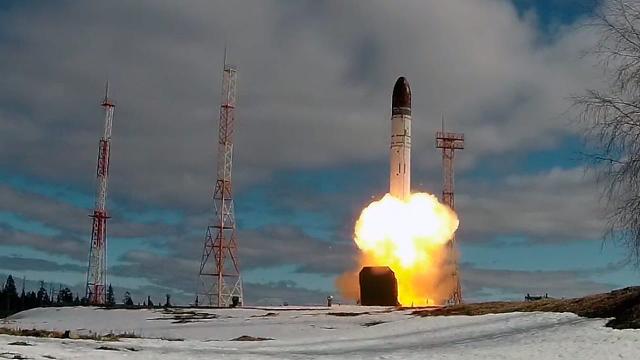
Launch of the Sarmat ICBM / Photo: ZVEZDA Shopping mall of the Russian Armed Forces. Ivanov
And in 55 minutes in orbit, you can go even further than the opposite point by 4670 km. Thus, while the Sarmat will pass its maximum 14,000 km, the warhead in orbit will cover 24,670 km, which is 1.76 times more. Here, the orbit clearly and significantly benefits from a slower ICBM.
But efficiency is not an absolute measure of weapon effectiveness. It does not exist in isolation from the other most important indicator: the area of impact coverage. What area is this operational strike targeting? And then a huge, drastic difference opens up.
The answer is different in terms of areas: there is no equal for ICBMs here.
The orbital placement of the warhead makes it possible to hit a target in a 100 km wide lane, less than one geographical degree (equal to 111 km distance). On a small globe, it's just a bold marker line. The ICBM has a fundamental difference: all-round launch. By virtue of any direction (azimuth) of the launch, the ICBM covers the circle with the center at the start. With the exception of the close vicinity of the launch, until all the rocket stages have worked out, the charge will not pass the necessary degrees of cocking (described here in the chapter "Protection and cocking system"). But there is no need to hit the launch area, it is its own territory.
As we remember, the circumference of the Earth is 40,000 km. A quarter of this circle is 10,000 km, the distance from the equator to the pole. This means that a missile with a range of 10,000 km (approximately 37 minutes of flight time) will cover a quarter of the Earth's circumference in one direction and a quarter in the opposite direction, for a total of 20,000 km of the affected area. This is exactly half of the Earth, the starting hemisphere with the center at the starting point.
A missile with a range of 14,000 km, like the Sarmat, will go another 4,000 km deep into the far hemisphere. That's a lot, and this huge band will run across the widest part of that hemisphere. Near the top of his head, there will be an area not covered by the missile's maximum range, probably a quarter of the Earth's surface (please clarify the estimate for meticulous readers).
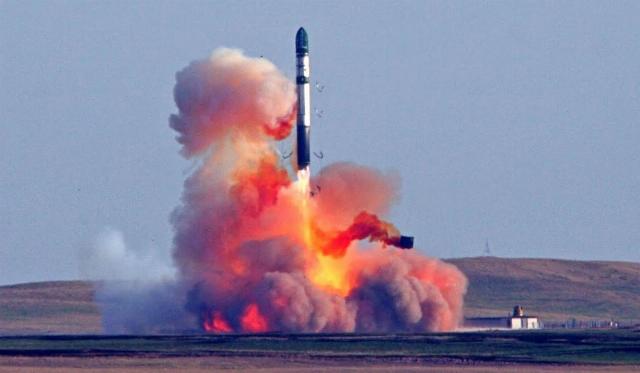
Launch of the Sarmat ICBM / Frame from a YouTube recording
An orbital ICBM will travel to the opposite point of the Earth in 50 minutes (3 minutes to accelerate, 3 minutes to enter the atmosphere, and 44 minutes of orbit), covering the entire Earth with damage.
And the orbital-based warhead? In the 37 minutes it takes an ICBM to cover the hemisphere, the orbital warhead will pass its 17,000 km with a 100 km kill zone. Let's compare these areas: the Earth's hemisphere is about 255 million square kilometers; the damage range of an orbital—based warhead in 37 minutes of flight is 1.7 million square kilometers, or 1/150 of the hemisphere area.
For ranges of 12,000 km, 14,000 km, this ratio will grow, reaching a maximum for an orbital ICBM covering the entire area of the Earth, 510 million km, in 50 minutes. Orbital basing during this time will give an area of 2.34 million square kilometers, 218 times less.
Earth rotation: easy for ICBMs, critical for in-orbit basing
The estimates above did not include the rotation of the Earth. But during the flight time, the planet will rotate both under the orbit and under the suborbital ICBM. The target will "float away" some distance to the east, determined by the target's latitude and flight time. This is not a problem for ICBMs: you just need to pre-empt the aiming point to this offset.
The situation is different for an orbital base. The target should be in the lane of the route, and at the right distance ahead of the warhead. What if the target missed the lane? Or did you get caught, but on the other side of the Earth? By the time the orbit leads there, the target may have already crawled out of the kill zone.
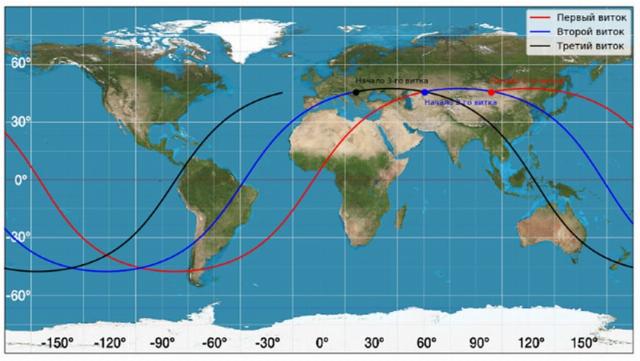
The displacement of the route of a low circular orbit due to the rotation of the Earth. The thickness of the route lines at this scale approximately corresponds to the 100-km band of available damage during the orbital basing of the warhead. The line is the same color and there is the entire affected area from the orbital base in one orbit, or an hour and a half of time / Source: profil.mos.ru
And the path of the orbit per turn can shift from zero at the pole to 2500 km at the equator. The next turn will shift the route again, to a different shift at different latitudes. You can wait a day, a week, or more until the lane overlaps with the target — or, in other words, until the target turns into the lane of the highway. The efficiency of such weapons loses its meaning in conditions when key cases occur and are resolved in a day. In such a situation, the efficiency of using weapons in the usual practical sense completely disappears. Either there will be no point in using it anymore, or there will be no one else.
Orbital Armada: how much does it take to strike?
To clarify: to hit a single target. It is possible to place enough warheads in orbits so that they are all together (each with its own 100-km lane) They completely covered the hemisphere in the same 37 minutes as one ICBM. This will require almost as many warheads as the area of impact of an ICBM exceeds the warhead band. It may be necessary to place 150-200 warheads in orbits instead of one ICBM warhead. "Almost as much": the corrections will be made by the exact geometry of the overlap of the routes, which will overlap each other in some places of the Earth. And the dynamics of the movement of the entire orbital system can also give its own adjustments, which makes no sense to delve into here.
But there are several warheads on the ICBM, distributed among a local territorial group of three to five targets. They are part of an ellipse of warhead impact points, approximately 100-150 km wide and 600-800 km long. For their operational and simultaneous attack with orbital-based warheads, it is necessary to multiply 150-200 orbital warheads by the number of targets. The final orbital grouping will be 450-1000 units, needed instead of one ICBM.
Does it make sense to create such a large orbital system with control centers all over the Earth, if it is replaced by one conventional Sarmat with a maximum range of 14,000 km? Launched from the Dombarovsky positioning area in the Orenburg region, it is capable of quickly hitting targets on any continent at any point, covering 3/4 of the planet's area. When launched from Dombarovka, only a desert zone in the southern and equatorial Pacific Oceans will remain untouched, containing neither significant land nor targets for ICBMs.
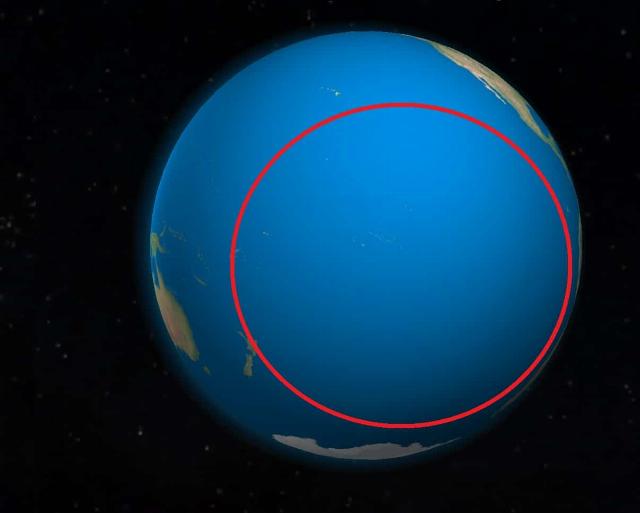
When the Sarmat ICBM is launched from Dombarovka with a maximum range of 14,000 km, only the desert zone in the southern and equatorial Pacific Oceans will remain untouched. This area is roughly indicated by a red border / Author's collage.
The material part: the design sets the tasks
Long-term placement in orbit, unlike an hour-long flight of an ICBM warhead, requires providing constructive solutions. An inexhaustible source of energy in the form of solar panels is needed for the continuous operation of orientation and communication systems with the Earth (the second is impossible without the first). And to them, there is a link for storing electricity for the shadow part of the loop.
Temperature control will also require devices in the form of cooling radiators, stock and refrigerant lines and pumps. The temperature control system must also serve a separate important issue of charge temperature control. Compact plutonium feels warm to the touch, like a living person; a kilogram of weapons-grade plutonium emits about 100 watts of thermal power. If the heat is not fully removed, the plutonium part will overheat and shrink from heating (the solid "weapon-grade" phase of plutonium has a negative coefficient of thermal expansion). Cracks and grooves will appear that disrupt high-precision processes during an explosion, and the normal energy output of the explosion will drop to a fault.
And that's not all the charge needs. If it uses tritium power boost (tritium boosting), it contains tritium. And the half-life of tritium is small, 12.3 years. Every 12.3 years, tritium is halved, and its amount is continuously decreasing over any period of time. Therefore, the tritium in the charge (often a capsule with a deuterium-tritium gas mixture) is replaced with a certain frequency.
But even without tritium, the charge requires routine maintenance. The plutonium part gradually changes its isotopic composition — it is precisely because of the nuclear reactions taking place in it that heat is released. Often, the lifetime of the entire charge is longer than the shelf life of its nuclear material, and then the plutonium part is replaced with a fresh one. How can this diverse service be carried out in space? To date, there is no technology for charge regulations in orbit.
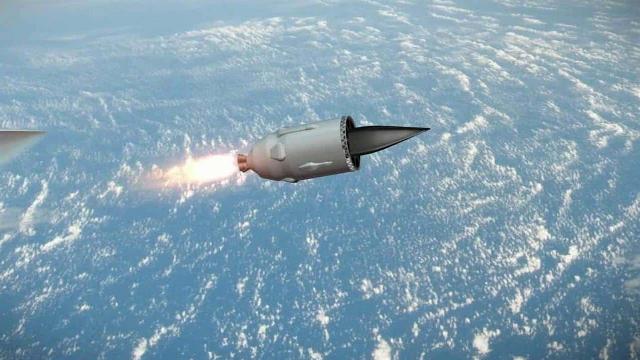
Frame from the video / Source: 1tv.ru
There is also a task on the braking impulse, the name of which is accuracy. In ICBMs, accuracy is ensured by the operation of a large and complex breeding stage. Its cost and labor costs for manufacturing are distributed over several warheads. When space-based, each warhead will require a design of comparable complexity, both with high-precision measurement of its current coordinates and movement, and with a precision actuating thrust.
Finally, the protection of a warhead from enemy weapons in orbit and in the mine is very different, and it is clear where it is higher and where it is weaker. The structure in orbit is open to kinetic action, laser heating, blinding of sensors, and "spoilage" of plutonium by a stream of neutrons from a thermonuclear explosion kilometers away. In the mine, these damaging factors will not reach the warhead.
As an epilogue
All these aspects — ballistic, technological, security, and others — clearly illustrate the huge difference between placing a warhead on an ICBM and in orbit. The balance of advantages, primarily combat, as well as technical, with a multiple advantage is on the side of the ICBM. The arguments for basing a warhead in orbit become unobvious and incomprehensible. This leads to the conclusion that the orbital basing of warheads is more mythical than realistic today.
If you fantasize, you can come up with an orbital armada of thousands of combat spacecraft. These orbital platforms can maneuver many times, changing both the inclination of the orbit and its course, as well as the altitude, period and other characteristics of the orbit. The platform is well protected from any weapon and carries several warheads, performing the work of the breeding stage for them. A reliable group management structure controls its general and local movement, separating platforms from other objects in space, and transmits on board the distribution and coordinates of targets and commands for combat use.
An equally reliable service structure in space conducts regulations on board combat platforms. It replaces warheads or their components, refuels them to maintain altitude and orbital maneuvers, and replaces obsolete platforms with new ones. Given that warheads cannot be burned in the atmosphere like spent satellites, they will not burn up, and the plutonium on board, and the chemical explosives that are available there, are not useful when falling to Earth.
This interesting picture is too magical to be viewed in reality today. Whether it will also be more effective than an ICBM missile division is a big question. There is a simple answer to this question: it is unlikely in the foreseeable future. Then it's up to him, this future. Which we can't reliably look into today.
Nikolai Tsygikalo
